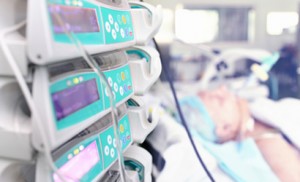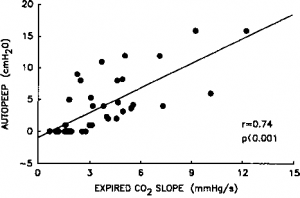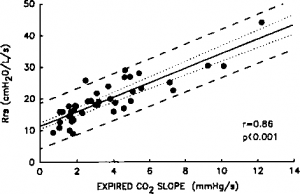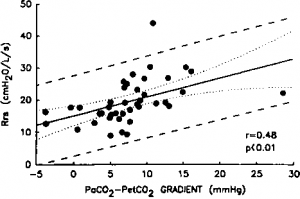Relationship Between Expired Capnogram and Respiratory System Resistance in Critically III Patients During Total Ventilatory Support – Results
 Our general population of patients had a variable degree of airflow obstruction, the Rrs ranging between 8.96 cm H20/L/s and 44.28 cm HzO/L/s (19.66 ± 1.07 cm H20/L/s) and the expired C02 slope ranging between 0.69 mm Hg/s and 12.3 mm Hg/s (3.61 ± 0.40 mm Hg/ s). The time set for expiration in the mechanical ventilator was 2.56 ± 0.09 s (range, 1.73 s to 3.75 s). Auto-PEEP was present in 25 of 41 patients (61 percent). All but four patients with COPD and the two asthmatic patients exhibited auto-PEEP during mechanical ventilation. Only 4 of these 25 patients with auto-PEEP had an expired C02 slope lower than 3 mm Hg/s. The mean value of expired C02 slope was 1.62 ± 0.13 mm Hg/s in patients without auto-PEEP and 4.88 ± 0.51 mm Hg/s in patients with auto-PEEP (p < 0.01), thus confirming our previous results that a very positive expired C02 slope identifies patients with auto-PEEP during mechanical ventilation. As shown in Figures 1 and 2, there was a significant correlation between auto-PEEP and Rrs (r = 0.75; p< 0.001) and between auto-PEEP and the expired C02 slope (г = 0.74; p < 0.001). buy allegra
Our general population of patients had a variable degree of airflow obstruction, the Rrs ranging between 8.96 cm H20/L/s and 44.28 cm HzO/L/s (19.66 ± 1.07 cm H20/L/s) and the expired C02 slope ranging between 0.69 mm Hg/s and 12.3 mm Hg/s (3.61 ± 0.40 mm Hg/ s). The time set for expiration in the mechanical ventilator was 2.56 ± 0.09 s (range, 1.73 s to 3.75 s). Auto-PEEP was present in 25 of 41 patients (61 percent). All but four patients with COPD and the two asthmatic patients exhibited auto-PEEP during mechanical ventilation. Only 4 of these 25 patients with auto-PEEP had an expired C02 slope lower than 3 mm Hg/s. The mean value of expired C02 slope was 1.62 ± 0.13 mm Hg/s in patients without auto-PEEP and 4.88 ± 0.51 mm Hg/s in patients with auto-PEEP (p < 0.01), thus confirming our previous results that a very positive expired C02 slope identifies patients with auto-PEEP during mechanical ventilation. As shown in Figures 1 and 2, there was a significant correlation between auto-PEEP and Rrs (r = 0.75; p< 0.001) and between auto-PEEP and the expired C02 slope (г = 0.74; p < 0.001). buy allegra
We considered whether expired capnogram moni-torization might be used in an intensive care setting to assess Rrs. To that end, linear regression analysis was used to compare direct measurements of Rrs with the expired CO0 slope and РаС02-РЕтС02 gradient in 41 mechanically ventilated patients. The results indicated a very good correlation between the expired C02 slope and Rrs over a wide range of values (r = 0.86; p< 0.001). The relationship between Rrs (cm H20/L/s) and the expired C02 slope (mm Hg) was given by the following function: Rrs = 11.42 + 2.28 expired C02 slope
Prediction interval limits at 95 percent confidence level for Rrs are approximately ± 7.39 cm H20/L/s (Fig 3).
The РаС02-РЕтС02 gradients varied from;ms3.8 mm Hg to 28.7 mm Hg (7.66 ± 0.87 mm Hg). A weak but significant association was found between Rrs and the РаС02-РЕтС02 gradient (r = 0.48; p < 0.01). The relationship between Rrs (cm H20/L/s) and the PaC02-PetC02 gradient (mm Hg) was given by the following function: Rrs = 15.15 + 0.58 РаС02-РЕтС0>7 gradient
Prediction interval limits at 95 percent confidence level for Rrs are approximately ± 12.72 cm H20/L/s (Fig 4).
Figure 1. Correlation between auto-PEEP and Rrs in 41 intubated critically ill patients.
Figure 2. Correlation between auto-PEEP and the expired C02 slope in 41 intubated critically ill patients.
Figure 3. Correlation between Rrs and the expired CO, slope in 41 intubated critically ill patients. Dotted lines represent 95 percent confidence intervals of the regression line. Long dashed lines represent 95 percent prediction intervals for a single observation.
Figure 4. Correlation between Rrs and the РаС0.,-РктС02 gradient in 41 intubated critically ill patients. Dotted lines represent 95 percent confidence intervals of the regression line. Long dashed lines represent 95 percent prediction intervals for a single observation.




Leave a Reply